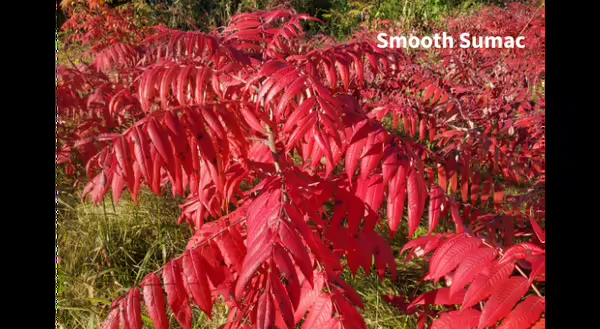
Shrubs are often overlooked in autumn, typically playing second fiddle to overtopping shade trees that steal the fall display. However, quite a few deciduous shrubs have spectacular fall color to offer in the landscape. In many settings these smaller woody plants can help provide eye-level fall interest in the garden as blooms fade and many of the herbaceous plants we rely on for beauty throughout the growing season just don’t have as much appeal.
In addition, there are numerous native shrubs that offer flamboyant fall foliage. In this article I review a few of my favorites with some tips on how to place them in the landscape for maximum appeal.
Black Chokeberry (Photinia melanocarpa)
Black chokeberry (originally Aronia melanocarpa, but recently reclassified as Photinia melanocarpa) is named for its astringent, yet edible, berries. While they can make delicious jam, the raw fruits are so bitter, they can cause a puckering reaction that some compare to choking. These tiny black berries are a great accent to its spectacular fall color. Simple, finely-toothed leaves turn a wonderful reddish-orange to almost purple in fall, with many plants sporting a range of those colors.
This smaller shrub matures to a height of 3-6 feet and works nicely as a specimen among other flowering plants in a landscape bed. I also really like this plant in small groupings to fill a back corner or provide some vertical structure with smaller plants in the foreground.
Black chokeberry is somewhat rare across Illinois, only known to occur a little over a dozen counties scattered in northern and southern Illinois, typically occurring in sandy, moist prairie or savannah settings in nature. It prefers full sun to partial shade and tolerates both wet and dry soil conditions, making it an excellent plant for any rain garden.
Smooth Sumac (Rhus glabra)
Smooth sumac is quite common across Illinois, known to occur in nearly every county. In central Illinois, its hard not to see it in most any drive through countryside as it quite regularly occupies less mowed ditches or unmowed edges of the right-of-way.
In fall, the color this plant provides is absolutely spectacular as its fern-like leaves turn a fiery orange to red hue. The sprawling stalks of compound leaves add a bit of course texture to this plant, but profusely display its fall beauty.
Smooth sumac performs best in full sun and tolerates part shade plus very dry and very sterile soil conditions with low nutrient levels. Perhaps its biggest enemy is poor drainage, it simply cannot stand “wet feet”.
It’s known to be an aggressive thicker forming shrub, which makes it a very poor specimen plant. It works best as a border or mass planting, creating a nice backdrop for other plants. It can be taller shrub, reaching heights of 15 ft or more. However, the plant can handle regular rejuvenation pruning to keep its size down and maintain a thicker stand of stems. Due to its tolerance of poor, disturbed soil conditions, this can also be a great plant for problem areas, steep banks or locations with recent cut or fill.
Allegheny serviceberry (Amelanchier laevis)
Allegheny serviceberry is a tall shrub that some may actually consider a small tree. Its native to northern portions of the state including Champaign and Vermilion counties. I just love the habit of this plant as it is usually multi-stemmed, which aids in the display of its unique, smooth bark. Fall color is brilliant red-orange color that almost glows as it reaches its peak.
Serviceberry is easily grown in full sun to partial shade and tolerates a wide range of soil conditions. This plant works wonderfully as the centerpiece of a native garden. Given its wide range of soil conditions it also works nicely to soften a woodland edge or on a streambank or pond edge. Looks great in any yard as a single specimen maintained to achieve maximum height, providing true four seasons of beauty.
2021 ECIMN Native Tree and Shrub Sale
If you are interested in adding any of these or other spectacular natives to your landscape, check out the East Central Illinois Mater Naturalists’ native tree and shrub sale at: https://go.illinois.edu/Natives. Ordering is open now through October 3, with plant pickup on October 16 in Urbana. Don’t miss this opportunity to boost the biodiversity in your home landscape!